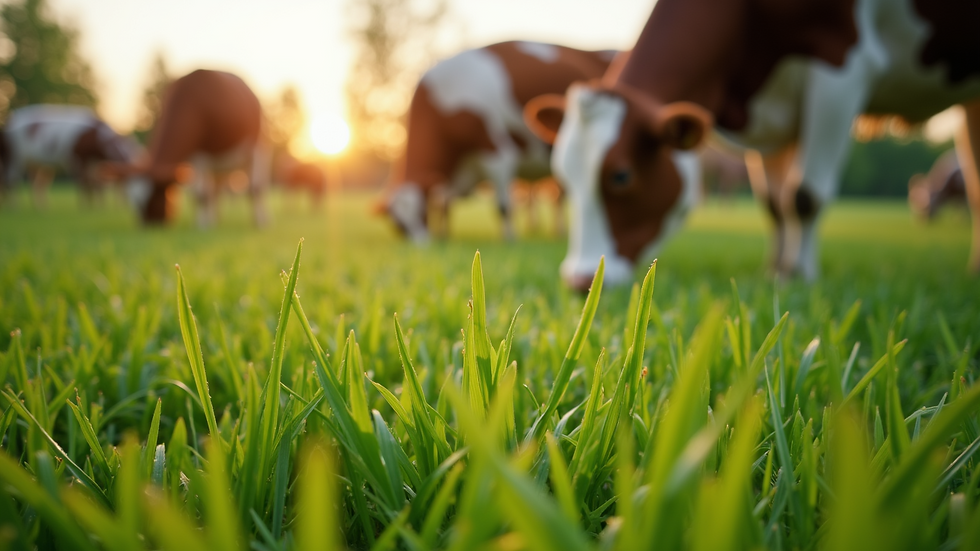The Environmental Impact of Grass-Fed Farming Practices
- Tim Geauvreau

- Aug 23
- 4 min read
When I first started working with local farmers to bring naturally raised meats to your door, I quickly realized how much the way animals are raised affects not just the quality of the meat but also the environment. Grass-fed beef farming, in particular, has a lot to offer when it comes to sustainability and environmental care. Today, I want to share what I’ve learned about the environmental impact of grass-fed beef farming and why it matters to all of us.
What Makes Grass-Fed Beef Different?
Grass-fed beef comes from cattle that eat only grass and forage throughout their lives, unlike conventional beef cattle that are often fed grains and confined in feedlots. This difference in diet and lifestyle changes everything about how the animals grow and how the land is managed.
Grass-fed cattle typically graze on pastures, which means they help maintain healthy grasslands. These pastures act like natural filters, absorbing rainwater and reducing soil erosion. Plus, the animals’ natural grazing patterns encourage plant growth and biodiversity.

One of the biggest environmental benefits of grass-fed beef is how it supports soil health. Healthy soil stores carbon, which helps fight climate change. When cattle graze properly, they stimulate root growth in grasses, which pulls carbon from the air and locks it into the ground. This process is called carbon sequestration, and it’s a natural way to reduce greenhouse gases.
How Grass-Fed Beef Farming Helps the Environment
Grass-fed beef farming offers several environmental advantages that make it a better choice for the planet. Here are some key benefits I’ve seen firsthand:
Reduced greenhouse gas emissions: Grass-fed cattle produce less methane compared to grain-fed cattle because their diet is more natural and easier to digest.
Improved water quality: Grazing animals on well-managed pastures reduce runoff and prevent harmful chemicals from polluting nearby water sources.
Enhanced biodiversity: Pastures support a variety of plants, insects, and wildlife, creating a balanced ecosystem.
Less reliance on fossil fuels: Grass-fed systems often require fewer inputs like synthetic fertilizers and pesticides, which are energy-intensive to produce.
By choosing grass-fed beef, you’re supporting farming practices that work with nature instead of against it. This means healthier land, cleaner water, and a smaller carbon footprint.

Supporting Local Farmers and Sustainable Practices
One of the things I love most about working with local farmers is seeing their commitment to sustainable farming. Many of these farmers use rotational grazing, which means they move cattle between different pastures regularly. This prevents overgrazing and allows grass to recover, keeping the soil rich and productive.
Rotational grazing also mimics natural herd movements, which benefits the land and the animals. It reduces the need for chemical fertilizers because the manure naturally fertilizes the soil. Plus, it helps control pests and weeds without harmful pesticides.
If you’re interested in trying grass-fed beef, I highly recommend checking out ontario grass-fed beef. These farmers are dedicated to raising cattle in a way that respects the environment and produces delicious, healthy meat.

Practical Tips for Choosing and Using Grass-Fed Beef
If you’re new to grass-fed beef, here are some simple tips to help you get started and make the most of this natural product:
Look for local sources: Buying from local farmers means fresher meat and supports sustainable agriculture in your community.
Understand the labels: Grass-fed means the cattle ate only grass, but some labels might also say “grass-finished,” which means the animal was on grass for its entire life.
Cook with care: Grass-fed beef is leaner than grain-fed, so it cooks faster and can dry out if overcooked. Try slow cooking or marinating to keep it tender.
Try different cuts: Grass-fed beef has a rich, earthy flavor. Experiment with steaks, roasts, and ground beef to find your favorites.
Store properly: Keep grass-fed beef in the fridge or freezer and use it within recommended times to enjoy the best taste and quality.
By choosing grass-fed beef, you’re not only making a healthier choice for yourself but also supporting farming methods that protect our planet.
Why Grass-Fed Beef Matters to Our Future
I believe that the way we raise our food has a huge impact on the world we live in. Grass-fed beef farming is a step toward a more sustainable future. It shows that we can enjoy quality meat without harming the environment.
Supporting local farmers who practice grass-fed beef farming means investing in healthier soils, cleaner water, and a balanced ecosystem. It also means helping small businesses thrive and keeping traditional farming knowledge alive.
If you want to make a positive difference, consider switching to grass-fed beef. It’s a simple change that benefits you, the farmers, and the planet.
Thank you for joining me on this journey to better understand the environmental impact of grass-fed beef farming. Together, we can make choices that nourish our bodies and protect our earth.
If you want to explore more about naturally raised meats and support local farmers, feel free to visit ontario grass-fed beef and discover the best options available right to your door.




Comments